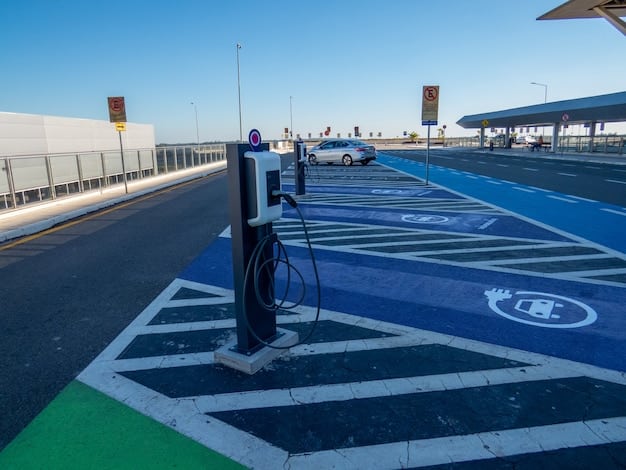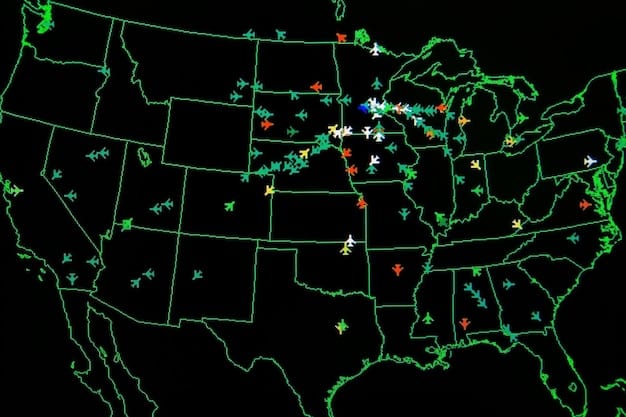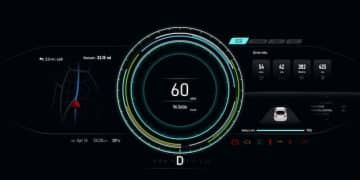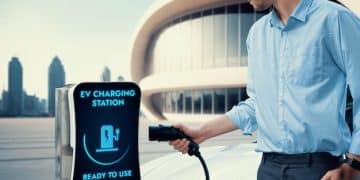Electric Vehicle Charging on US Highways: Road Ready by 2025?

Electric Vehicle Charging Infrastructure Updates: Are US Highways Ready for 2025? This article explores the progress of electric vehicle (EV) charging infrastructure along US highways, assessing whether current developments and planned expansions are sufficient to meet the anticipated demand by 2025 and beyond.
Are United States highways prepared for the electric vehicle revolution in 2025? The implementation of practical and accessible charging infrastructure for electric vehicles is important. This article examines the **Electric Vehicle Charging Infrastructure Updates: Are US Highways Ready for 2025**, scrutinizing the ongoing efforts to construct a nationwide charging network and evaluating its ability to serve the increasing number of EV drivers.
The Current State of EV Charging Infrastructure in the US
The landscape of electric vehicle (EV) charging infrastructure across the United States is rapidly evolving, but significant challenges remain in ensuring it is robust and accessible enough to meet the growing demand. Several factors, including the uneven distribution of charging stations and varying levels of charging speeds, affect the overall readiness.
To evaluate the current state, it’s essential to consider not only the quantity of charging stations but also their quality, reliability, and strategic placement along major US highways. Federal and state initiatives are trying to accelerate the expansion and enhancement of this infrastructure, but the question is whether these efforts are keeping pace with the exponential growth of EV adoption.
Distribution of Charging Stations
The current distribution of EV charging stations across the US is uneven, with a concentration in urban areas and along the coasts. Many states in the heartland lack sufficient charging infrastructure, creating gaps in the network that deter long-distance EV travel. This disparity poses challenges for drivers crossing the country and highlights the need for a more balanced approach to infrastructure development.
Charging Speed and Technology
Charging speeds vary significantly among different types of EV chargers. Level 1 and Level 2 chargers, which are commonly found in residential and commercial locations, offer slower charging speeds, adding several hours to the charging process. DC fast chargers, on the other hand, can provide a substantial charge in a much shorter time frame, making them essential for highway travel. The availability and reliability of these fast-charging stations are critical factors in assessing the readiness of US highways for EVs by 2025.

Key factors affecting EV charging infrastructure readiness:
- Number of Charging Stations: The total count of available charging stations and how it compares to the number of EVs on the road.
- Charging Speed: The prevalence and availability of DC fast chargers versus slower Level 1 and Level 2 chargers.
- Geographic Distribution: The balance of charging stations across different states and regions, focusing on highway corridors.
- Reliability and Maintenance: The uptime and maintenance of existing charging stations to ensure they are operational when needed.
In conclusion, the current state of EV charging infrastructure in the US reveals a landscape of progress and challenges. While advancements have been made, the uneven distribution, varying charging speeds, and ongoing reliability issues need to be addressed to ensure US highways are truly ready for the EV revolution by 2025.
Federal Initiatives and Funding for EV Infrastructure
To hasten the development of EV charging infrastructure, the United States government has introduced several initiatives and dedicated substantial funding through different programs. These federal efforts are designed to encourage investment, streamline regulatory procedures, and foster collaboration among stakeholders to accelerate the widespread deployment of charging stations.
Understanding these federal initiatives and the funding mechanisms is crucial to assessing how rapidly and effectively the US highway system can adapt to accommodate the growing number of electric vehicles. These programs aim to eliminate some of the financial barriers and encourage innovation in charging technology.
The National Electric Vehicle Infrastructure (NEVI) Formula Program
The NEVI Formula Program, established under the Bipartisan Infrastructure Law, is a key federal initiative aimed at providing states with funds to build out EV charging infrastructure along designated Alternative Fuel Corridors. This program allocates billions of dollars to states over five years, enabling them to strategically deploy charging stations and improve the overall EV charging network.
Grants and Incentives for Charging Station Deployment
In addition to the NEVI Formula Program, several grant programs and tax incentives are available to support the deployment of EV charging stations. These incentives are aimed at private companies, local governments, and utilities, encouraging them to invest in EV infrastructure projects. These incentives can significantly reduce the cost of deploying charging stations, making it more attractive for businesses and organizations to participate in building out the charging network.

Key Federal Initiatives and Funding Mechanisms:
- NEVI Formula Program: Provides states with funds to build EV charging infrastructure along Alternative Fuel Corridors.
- Grants and Incentives: Offers financial support to private companies, local governments, and utilities for EV charging station deployment.
- Bipartisan Infrastructure Law: Allocates substantial funding towards EV infrastructure projects and related initiatives.
- Joint Office of Energy and Transportation: Facilitates collaboration between federal agencies, state and local governments, and private sector stakeholders to accelerate EV infrastructure deployment.
In conclusion, federal initiatives and funding mechanisms play a crucial role in accelerating the development of EV charging infrastructure across the United States. These programs provide financial support, promote collaboration, and establish regulatory frameworks to enable the widespread deployment of charging stations, facilitating the transition to an electric vehicle future.
Challenges in Scaling EV Charging Infrastructure Along Highways
Despite federal funding and programs, expanding the EV charging infrastructure along US highways encounters several challenges. These obstacles range from technical and logistical issues to regulatory and economic hurdles.
Understanding these challenges is going to be critical for policymakers, industry stakeholders, and EV enthusiasts to effectively move forward and provide practical solutions. Addressing these challenges is necessary to guarantee that EVs can easily traverse US highways by 2025.
Permitting and Regulatory Hurdles
Acquiring permissions and approvals for constructing EV charging stations can be a time-consuming and complex process. Different jurisdictions may have varying zoning regulations, environmental requirements, and safety standards, resulting in delayed project timelines. Streamlining these regulatory processes is essential to accelerate the deployment of charging infrastructure.
Grid Capacity and Upgrades
The additional load from EV chargers on the electrical grid requires upgrades in many areas. Many local grids cannot accommodate the power draw from multiple fast charging stations without huge upgrades. Managing grid capacity and coordinating with utility providers is crucial to ensuring a reliable and sustainable charging network.
Private Sector Investment and ROI
Private companies hesitant to invest in EV charging infrastructure due to uncertain return on investment (ROI) and financial risks slows down development. Creating business models, providing financial support, and reducing regulatory uncertainty can incentivize private sector participation and accelerate the deployment of charging stations.
The main challenges in scaling EV charging infrastructure:
- Permitting and Regulatory Issues: Streamlining processes to reduce delays in constructing charging stations.
- Grid Capacity and Upgrades: Upgrading the electrical grid to handle the additional load from EV chargers.
- Private Sector Investment: Incentivizing private companies to invest in EV charging infrastructure.
- Equity and Accessibility: Ensuring equitable access to charging infrastructure for all communities.
Despite advancements in technology, the US highway system must tackle logistical issues, regulatory and economic hurdles, and grid capacity, if it is to meet EV charging demands by 2025. Policymakers, industry stakeholders, and EV enthusiasts must address these issues to move forward and provide practical solutions.
Technological Advancements in EV Charging
Technological advancements are revolutionizing EV charging, enhancing speed, efficiency, and user experience. These innovations are driving the development of next-generation charging solutions that can meet the demands of a rapidly growing EV market.
Exploring these technological advancements provides insights into how the future of EV charging may look and how US highways will enable EV travel by 2025. These breakthroughs can change the game in long-distance EV travel.
Ultra-Fast Charging Technology
Ultra-fast charging technology is significantly reducing charging times, allowing EVs to gain considerable range in just minutes. These high-power chargers, which can deliver up to 350 kW, are becoming more prevalent along major highways, easing range anxiety and making long-distance EV travel more convenient.
Wireless Charging Solutions
Wireless charging technology offers a convenient and hands-free charging experience. While still in the early stages of deployment, wireless charging pads installed in parking spots and dedicated charging lanes can automatically charge EVs without the need for cables. This technology holds promise for enhancing the overall user experience and simplifying EV charging.
Battery Technology and Energy Storage
Advancements in battery technology are improving energy density, range, and charging capabilities of EVs. Solid-state batteries, for example, offer greater energy storage capacity, faster charging times, and enhanced safety compared to traditional lithium-ion batteries. These battery innovations, combined with advanced energy storage systems, can play a crucial role in enabling faster and more efficient charging along US highways.
Key Technological Advancements and Innovations:
- Ultra-Fast Charging: Reducing charging times with high-power chargers.
- Wireless Charging: Hands-free charging using wireless pads and dedicated lanes.
- Battery Technology: Improving energy density, range, and charging capabilities with solid-state and lithium-ion batteries.
- Smart Charging: Managing energy demand and optimizing charging schedules using data analytics and grid integration.
Ultra-fast charging, wireless solutions, and energy storage are transforming EV charging. These improvements are improving the speed, efficiency, and user experience. The United States must embrace these innovations as it works to make US highways EV-friendly by 2025.
The Role of Renewable Energy in EV Charging Infrastructure
Integrating renewable energy sources into EV charging infrastructure presents opportunities to reduce carbon emissions and improve charging. By using solar, wind, and other renewables to power charging stations, EVs can become even more environmentally friendly.
Examining the role of renewable energy is vital for understanding how sustainable and resilient EV charging can be. Integrating renewable energy into EV charging infrastructure can result in significant environmental and economic benefits.
Solar-Powered Charging Stations
Solar-powered charging stations are becoming increasingly common, especially in areas with abundant sunlight. These stations use photovoltaic panels to convert sunlight into electricity, which can then be used to charge EVs. Solar-powered charging stations can reduce reliance on the grid, lower electricity costs, and decrease the carbon footprint of EV charging.
Wind Energy Integration
Wind energy can also be integrated into EV charging infrastructure, particularly in regions with favorable wind resources. Wind turbines can generate electricity that is used to power charging stations, offering a sustainable and renewable energy source. Integrating wind energy into EV charging can reduce emissions and support the growth of renewable energy industries.
Energy Storage Solutions
Energy storage solutions, such as batteries and pumped hydro storage, play a crucial role in renewable energy-powered EV charging infrastructure. These storage systems can store excess electricity generated from renewable sources during periods of high production and release it during times of peak demand.
The role of renewable energy in EV charging:
- Solar-Powered Stations: Reduces reliance on the grid, lowers electricity costs, and decreases carbon footprint.
- Wind Energy Integration: Offers a sustainable and renewable energy source for powering charging stations.
- Energy Storage Solutions: Stores excess electricity for use during peak demand, enhancing grid stability and reliability.
- Microgrids: Enables self-sufficient energy systems, improving resilience and reducing reliance on centralized power grids.
Integrating renewables into EV charging significantly lowers the environmental effects of electric transportation. Solar, wind, and energy storage improvements not only strengthen the environment, but also encourage economic benefits, enabling a more sustainable and resilient EV charging infrastructure on US highways.
Future Outlook and Predictions for EV Charging on US Highways
Looking ahead, the future of EV charging on US highways holds great promise, with advancements and developments anticipated to change the landscape and improve the EV driving experience. Evaluating these future trends can help assess whether US highways will meet the demands of a rising EV market by 2025.
Keeping abreast of these advancements and developments is essential for policymakers, industry stakeholders, and EV enthusiasts. With continued investment, collaboration, and technology, the future of EV charging on US highways is expected to evolve, supporting a more sustainable and practical transportation ecosystem.
Increased Deployment of Fast Charging Stations
The deployment of DC fast charging stations along US highways is expected to accelerate in the coming years. Federal and state initiatives, combined with private sector investments, will drive the construction of additional fast charging stations, reducing range anxiety and allowing long-distance EV travel. The increased availability of fast charging stations will make EVs more appealing, helping broader consumer acceptance.
Standardization of Charging Protocols
Standardizing charging protocols is critical for improving interoperability and user experience. Efforts are underway to establish standard charging connectors, communication protocols, and payment systems, making it easier for EV drivers to charge at different stations. Standardization will streamline the charging process, ensure interoperability, and promote a more seamless experience across various networks.
Smart Charging and Grid Integration
Smart charging and grid upgrades help ensure stable charging while lowering the electricity grid’s load. Smart charging systems use data analytics to manage energy and balance local grids, minimizing strain. Integrating renewable energy sources such as solar and wind enhances sustainability, lowering carbon emissions and creating a more resilient charging environment.
Predictions for EV Charging on US Highways:
- Increased Fast Charging: More chargers, decreased anxiety, and easier long-distance trips.
- Standard Charging Protocols: Easier for EV drivers on any network.
- Smart grids: Using data to balance the load on local networks, and adding renewable sources to reduce emissions.
The future of EV charging on US highways appears bright. With more investments, ongoing improvements, and creative solutions, the EV charging environment will transform.
| Key Point | Brief Description |
|---|---|
| ⚡ Federal Funding | NEVI and grants aim to expand charging infrastructure along highways. |
| ⏱️ Charging Speed | Ultra-fast charging tech reduces charging times significantly. |
| ☀️ Renewable Energy | Solar and wind integration makes charging more sustainable. |
| ⚖️ Standardization | Charging protocols are becoming more standardized for easy use. |
Frequently Asked Questions
▼
The NEVI Formula Program, established under the Bipartisan Infrastructure Law, provides funds to states for building EV charging infrastructure along designated Alternative Fuel Corridors, supporting the strategic deployment of charging stations.
▼
Ultra-fast charging technology significantly reduces charging times, allowing EVs to gain considerable range in just minutes, easing range anxiety and making long-distance EV travel more convenient for drivers.
▼
Renewable energy sources like solar and wind power can be integrated into EV charging infrastructure to reduce carbon emissions and improve sustainability. This integration lowers electricity costs and decreases the carbon footprint.
▼
Standardization of charging protocols is important for improving interoperability and user experience, ensuring that EV drivers can easily charge at different stations with standard connectors and payment systems.
▼
The main challenges include dealing with permitting and regulatory hurdles, upgrading grid capacity, incentivizing private sector investment, and ensuring equitable access to charging infrastructure for all communities.
Conclusion
In conclusion, while progress has been made in expanding EV charging infrastructure along US highways, significant work remains to ensure readiness by 2025. Federal initiatives, technological advancements, and renewable energy integration all contribute to a more sustainable and efficient charging environment. Addressing challenges like regulatory hurdles and grid capacity, and continuing to invest in standardization and smart charging solutions, will be key to fully supporting the growing number of electric vehicles on the road.





